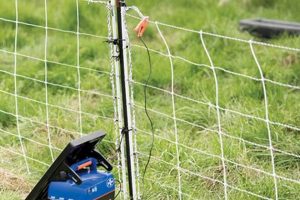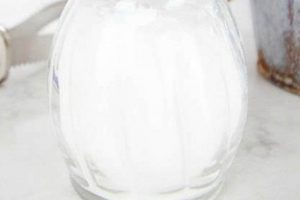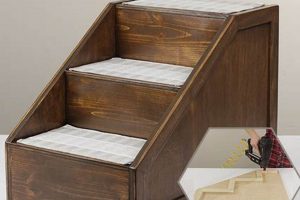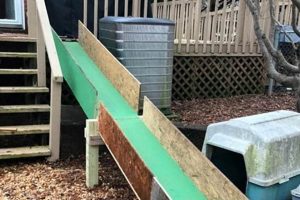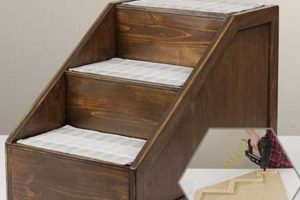Creation of substitute protective devices for canines, utilizing readily available materials and do-it-yourself methods, aims to provide an alternative to the traditional Elizabethan collar. Such projects often involve modifying items like inflatable neck pillows, fabric remnants, or even repurposed clothing to form a barrier preventing the animal from reaching wounds or surgical sites. The purpose is to offer a more comfortable and less restrictive recovery experience for the dog.
The significance of crafting custom protective solutions for dogs lies in addressing the discomfort and anxiety frequently associated with conventional veterinary cones. These DIY solutions can enhance the animal’s quality of life during recovery, promoting better sleep and reduced stress. Historically, pet owners have sought innovative methods to improve animal care, driven by a desire for humane and cost-effective alternatives to commercially available products.
Therefore, exploring the various materials and techniques suitable for constructing these custom devices is essential. A detailed examination of the benefits and drawbacks of specific designs will allow owners to make informed choices. Finally, safety considerations and proper fitting guidelines must be highlighted to ensure the solution effectively protects the injury site without causing additional harm or discomfort.
Practical Guidance for Constructing Canine Protective Devices
The following recommendations offer guidance in the creation of substitute protection for canines, facilitating a more comfortable recovery while adhering to safety standards.
Tip 1: Material Selection is Paramount: Opt for soft, breathable fabrics such as cotton or fleece to minimize irritation and maximize comfort. Avoid materials that could potentially fray or be easily ingested by the animal.
Tip 2: Prioritize Proper Fit: Accurate measurements are crucial. Ensure the device extends beyond the snout to effectively prevent access to the wound site. However, the device must not impede the animals breathing or vision.
Tip 3: Implement Adjustable Closures: Incorporate adjustable straps or fasteners to accommodate variations in neck size and prevent slippage. Hook-and-loop closures are a common and readily adjustable option.
Tip 4: Consider an Inflatable Collar Option: Commercially available inflatable collars provide a less restrictive alternative. Ensure the chosen inflatable collar is properly inflated and fits snugly to prevent the animal from reaching the affected area.
Tip 5: Adapt Existing Garments: Repurpose old t-shirts or infant onesies. Modify these items to create a body suit, ensuring the affected area is fully covered and inaccessible. Ensure the garment allows for unrestricted movement of the limbs.
Tip 6: Monitor the Animal Closely: Regardless of the chosen method, constant supervision is vital, especially during the initial period of use. Observe the animal for signs of distress, skin irritation, or attempts to circumvent the protective device.
Tip 7: Hygiene Maintenance: Regularly clean the protective device. The fabric may trap moisture or debris, leading to skin infections. Wash and dry thoroughly to prevent bacterial growth.
Adherence to these principles promotes successful implementation and reduces the risk of complications during the animals recovery period. Thoughtful crafting offers a viable alternative, prioritizing comfort and safety.
These alternatives, when implemented correctly, can significantly contribute to a more positive healing experience. However, it is vital to consult with a veterinarian to confirm the suitability of the chosen method and rule out any potential contraindications.
1. Material Safety
The selection of materials in “dog cone alternative diy” projects directly impacts the well-being of the animal. Inappropriate materials can cause adverse reactions, leading to skin irritation, allergic responses, or toxicity if ingested. For instance, fabrics treated with chemical dyes or containing synthetic fibers may trigger dermatitis, while small plastic components could present a choking hazard if detached. Therefore, the prioritization of material safety is not merely a precautionary measure but a fundamental requirement for ethical and effective “dog cone alternative diy” practices.
A concrete example illustrating the importance of material safety involves the use of certain types of stuffing in homemade inflatable collars. If the stuffing consists of small polystyrene beads, and the collar is punctured, the beads can be easily ingested by the animal, potentially causing intestinal blockage. Consequently, safer alternatives, such as cotton batting or shredded memory foam, are more suitable. Similarly, when crafting fabric-based solutions, natural, undyed materials like organic cotton are preferred over synthetic blends due to their reduced potential for causing allergic reactions. The avoidance of materials containing phthalates or BPA is also vital, as these chemicals are known endocrine disruptors.
In summary, the connection between material safety and “dog cone alternative diy” is inextricable. The choice of materials directly influences the animal’s health and comfort during recovery. Mitigating risks through careful selection is essential for creating safe and effective alternatives to traditional veterinary cones. Understanding these considerations underscores the ethical responsibility associated with “dog cone alternative diy” and highlights the need for thorough research and informed decision-making.
2. Proper Sizing
The principle of proper sizing represents a crucial element within “dog cone alternative diy”, directly impacting the efficacy and safety of the crafted protective device. Accurate sizing ensures the device fulfills its intended purpose of preventing access to wounds or surgical sites while simultaneously minimizing discomfort and potential complications for the animal.
- Effective Wound Coverage
Insufficient length of a DIY protective device will negate its primary function, allowing the animal to reach and potentially aggravate the affected area. Conversely, excessive length could obstruct the animal’s vision or impede movement, increasing the risk of accidents. Achieving the correct length is therefore essential for both protecting the wound and preserving the animal’s mobility and awareness. For example, an Elizabethan collar alternative that is too short might allow a dog to lick a leg wound, while one that is too long might cause it to bump into furniture, potentially reopening the wound.
- Neck Circumference and Security
The circumference of the protective device must correspond accurately to the animal’s neck size. A device that is too loose provides inadequate protection, enabling the animal to slip it off or reach around it. Conversely, an excessively tight device can restrict breathing, impede swallowing, or cause skin irritation. Secure fastening mechanisms that allow for adjustability are vital for maintaining a snug yet comfortable fit. An example of this is a neck pillow alternative, which, if too loose, won’t prevent the dog from turning its head to lick a wound, or a fabric collar that, if too tight, could cause choking.
- Weight and Balance Considerations
The weight of the DIY protective device must be proportionate to the animal’s size and strength. An overly heavy device can strain the neck muscles, disrupt balance, or cause fatigue. The weight distribution should be even to prevent tilting or slipping. For instance, a large, heavy DIY cone on a small dog might cause it to stumble, while an unevenly weighted device might constantly slide to one side, exposing the wound. It is also worth considering where the weight is distributed. Is it around the whole neck, like an inflatable collar? Or is it primarily at the front, like a fabric cone?
In essence, proper sizing in “dog cone alternative diy” represents a nuanced balance between protection, comfort, and safety. Each dimension and feature of the constructed device must be carefully tailored to the individual animal’s anatomy and needs to ensure optimal healing and a positive recovery experience. Failure to address sizing accurately can compromise the device’s effectiveness and potentially harm the animal, thereby undermining the very purpose of seeking a DIY alternative. When in doubt, consulting with a veterinarian or veterinary technician to confirm sizing is appropriate would be a good idea.
3. Comfort
Comfort is a central consideration within “dog cone alternative diy,” directly influencing the animal’s stress levels, healing rate, and overall well-being during the recovery period. The conventional Elizabethan collar, while effective at preventing access to wounds, often induces anxiety and discomfort due to its rigid structure and limited field of vision. Therefore, prioritizing comfort in do-it-yourself alternatives represents a critical factor in improving the animal’s experience.
- Material Softness and Breathability
The texture and composition of materials used in DIY cones directly impact comfort. Stiff or abrasive fabrics can cause skin irritation, chafing, and pressure sores, particularly in animals with sensitive skin. Soft, breathable materials, such as fleece or cotton, reduce friction and allow for adequate ventilation, minimizing discomfort and promoting healing. An example would be using a repurposed cotton t-shirt for the cone’s outer layer and filling it with soft batting, rather than using stiff canvas. Using breathable materials is even more vital in warmer climates.
- Range of Motion and Mobility
Traditional cones restrict an animal’s ability to move freely, impacting activities such as eating, drinking, sleeping, and navigating familiar surroundings. DIY alternatives designed with greater flexibility and a wider range of motion can reduce these limitations, allowing the animal to engage in essential behaviors with less difficulty. An example would be an inflatable collar which allows greater side to side neck motion than a traditional e-collar. This improved mobility reduces frustration and promotes a more relaxed state. A donut shaped pillow is an alternative.
- Weight and Balance Distribution
The weight and balance of the DIY cone significantly contribute to the animal’s comfort level. Heavy or unevenly distributed weight can strain the neck muscles, leading to discomfort and fatigue. Lightweight materials and balanced designs minimize strain and allow for more natural posture and movement. As an example, a light weight fabric collar avoids weighing down a small dog’s neck. Distributing the weight evenly around the neck, as with an inflatable collar, also prevents strain.
- Psychological Well-being
The design of the cone impacts an animal’s psychological state. Opaque materials or designs that excessively restrict vision can cause anxiety and disorientation, particularly in animals prone to fearfulness. Open designs or transparent materials allow for greater visibility, reducing anxiety and promoting a sense of security. For instance, opting for a clear plastic material for a DIY cone allows the animal to maintain visual contact with its surroundings, mitigating feelings of isolation and fear. Some dogs may benefit from the “Calming” style cones. These provide less visibility but limit stimuli, resulting in a calmer demeanor.
These considerations underscore the integral relationship between comfort and “dog cone alternative diy”. By prioritizing comfort through careful material selection, ergonomic design, and consideration of psychological well-being, pet owners can create protective devices that not only prevent access to wounds but also enhance the animal’s quality of life during recovery. Balancing the need for protection with the animal’s comfort is paramount in promoting optimal healing outcomes and minimizing distress.
4. Functionality
Within the realm of “dog cone alternative diy,” functionality represents the linchpin connecting design and purpose. It dictates whether the constructed device effectively fulfills its intended role of safeguarding wounds and surgical sites, while simultaneously considering the animal’s comfort and well-being. Therefore, functionality is not merely a feature but the core determinant of a successful alternative.
- Restriction of Access to Injury
The primary function of any “dog cone alternative diy” solution is to physically prevent the animal from reaching the affected area with its mouth, paws, or claws. This requires a design that extends beyond the snout and provides sufficient coverage to encompass the wound site, regardless of the animal’s flexibility. A poorly designed alternative, such as one with gaps or insufficient length, compromises this crucial function, rendering it ineffective. For instance, a neck pillow alternative that allows the animal to bend its head and lick a leg wound fails in its purpose.
- Unimpeded Movement and Essential Activities
While restricting access to the injury is paramount, a functional “dog cone alternative diy” solution must also permit the animal to engage in essential activities, such as eating, drinking, sleeping, and eliminating, with minimal disruption. A design that excessively restricts movement or obstructs access to food and water sources compromises the animal’s quality of life and can hinder the healing process. An example would be a body suit that fits so snugly that the dog can not comfortably sit, stand, or relieve itself.
- Durability and Resistance to Tampering
A functional alternative must be durable enough to withstand the animal’s normal activities and resistant to tampering or removal. Materials that are easily torn or fasteners that can be readily undone compromise the device’s effectiveness and necessitate frequent repairs or replacements. A poorly constructed device can quickly become useless if the animal manages to chew through it or wriggle free. To illustrate, a fabric cone secured with weak Velcro fasteners might be easily removed, while one constructed from durable, reinforced material with robust closures would provide more reliable protection.
- Ease of Application and Removal
The practicality of a “dog cone alternative diy” solution extends to the ease with which it can be applied and removed. A cumbersome or complicated design can cause unnecessary stress for both the animal and the owner. A functional alternative should be easy to put on and take off without causing discomfort or requiring excessive manipulation of the animal. For example, a simple slip-on design or one with easily accessible fasteners would be more user-friendly than a complex contraption requiring multiple steps.
These facets highlight that functionality in “dog cone alternative diy” involves a delicate equilibrium between protection, practicality, and animal welfare. A successful alternative must not only prevent access to the injury but also integrate seamlessly into the animal’s daily life, minimizing disruption and promoting a positive recovery experience. A holistic approach to functionality ensures that the solution is both effective and humane.
5. Durability
The relationship between durability and “dog cone alternative diy” is direct and critical. The lifespan and efficacy of a homemade protective device hinge on its ability to withstand the rigors of daily use by an active animal. A lack of durability negates the time and effort invested in its creation and compromises the animal’s recovery. If the device fails prematurely, the animal may gain access to the injury site, leading to complications such as infection, delayed healing, or the need for further medical intervention. For example, a fabric-based cone constructed with weak seams is likely to tear under normal wear, rendering it useless within a short period. Similarly, an inflatable collar made from thin, easily punctured material is prone to deflation, leaving the animal unprotected.
The practical significance of durability extends beyond mere cost-effectiveness. A durable device reduces the need for frequent replacements, minimizing stress for both the animal and the owner. Less frequent handling also decreases the risk of accidentally irritating the wound site. Furthermore, the choice of materials and construction techniques significantly impacts comfort. Sturdy materials that retain their shape and structural integrity provide consistent support, preventing sagging or collapsing that could cause discomfort or expose the wound. For example, reinforcing seams with durable stitching and selecting tear-resistant fabrics can significantly extend the lifespan of a fabric cone. Similarly, choosing high-quality, puncture-resistant materials for inflatable collars ensures reliable protection over an extended period. Some owners use rip-stop nylon and triple stitch construction.
In summary, durability is not an optional feature but a fundamental requirement in “dog cone alternative diy”. It ensures the long-term effectiveness of the protective device, minimizes the risk of complications, and enhances the animal’s comfort and well-being. Addressing durability challenges through careful material selection and robust construction techniques is essential for creating alternatives that are both practical and humane, resulting in a successful recovery. A design that neglects durability may ultimately prove more costly and detrimental than a commercially available option.
6. Cleanliness
The maintenance of cleanliness in “dog cone alternative diy” solutions is inextricably linked to the prevention of infection and the promotion of optimal wound healing. Homemade protective devices, by nature of their construction and materials, can harbor bacteria, fungi, and other pathogens if not regularly cleaned. This contamination poses a direct threat to the healing wound, potentially leading to localized or systemic infections, increased inflammation, and delayed recovery. The porous nature of many fabrics commonly used in DIY projects provides an ideal environment for microbial growth, particularly in the presence of moisture and organic debris. A contaminated device in direct contact with a surgical site or open wound can introduce pathogens, negating the benefits of the protective barrier. For instance, a fabric cone that is not routinely washed can accumulate saliva, skin cells, and environmental contaminants, creating a breeding ground for bacteria, thereby increasing the risk of infection.
The practical implications of maintaining cleanliness in “dog cone alternative diy” extend to the selection of appropriate materials and design features. Fabrics that are easily washable and quick-drying, such as cotton or microfiber, are preferable to those that retain moisture or require specialized cleaning methods. Designs that allow for easy disassembly and reassembly facilitate thorough cleaning of all components. The incorporation of antimicrobial finishes or the use of silver-impregnated fabrics can provide an additional layer of protection against microbial growth. Real-world applications demonstrate the effectiveness of these strategies. For example, a homemade inflatable collar with a removable, machine-washable cover allows for convenient and regular cleaning, minimizing the risk of contamination. Similarly, a fabric cone constructed with breathable, quick-drying materials reduces the likelihood of moisture accumulation and microbial proliferation.
In conclusion, cleanliness is not merely an ancillary consideration but a fundamental component of successful “dog cone alternative diy”. It directly influences the risk of infection, the rate of wound healing, and the overall well-being of the animal. Neglecting cleanliness can undermine the benefits of the protective device, potentially leading to adverse outcomes and increased healthcare costs. A comprehensive understanding of the relationship between cleanliness and wound health is essential for creating safe and effective DIY alternatives, reinforcing the need for meticulous attention to hygiene throughout the construction, use, and maintenance of these devices. A simple cleaning schedule should be maintained.
7. Veterinarian Approval
Veterinarian approval constitutes a critical validation step within the implementation of “dog cone alternative diy” solutions. It serves as a safeguard, ensuring that the selected alternative is medically appropriate for the specific condition and individual animal, preventing potential harm and optimizing the recovery process.
- Assessment of Suitability
A veterinarian possesses the expertise to assess the suitability of a proposed DIY alternative based on the nature and location of the wound or surgical site, the animal’s temperament, and its overall health status. The professional evaluation considers factors such as the risk of infection, the potential for self-trauma, and the animal’s ability to tolerate the device. For instance, a veterinarian might advise against a particular fabric cone design for an animal with a known allergy to certain materials or recommend an inflatable collar instead of a rigid alternative for a brachycephalic breed prone to breathing difficulties.
- Identification of Contraindications
Veterinarian consultation can uncover contraindications that might not be apparent to a pet owner. Certain medical conditions or behavioral traits can render specific DIY alternatives unsuitable or even dangerous. An animal with a history of anxiety or claustrophobia might react negatively to a restrictive body suit, while one with a tendency to chew excessively could quickly destroy a fabric cone, potentially ingesting harmful materials. A veterinarian’s knowledge of the animal’s medical history and behavioral patterns allows for the identification of such risks, preventing adverse reactions and ensuring the animal’s safety.
- Customization and Modification Guidance
A veterinarian can provide valuable guidance on customizing or modifying a DIY alternative to better suit the animal’s individual needs and the specific characteristics of the injury. This might involve adjusting the size, shape, or materials used in the design, or recommending specific fastening mechanisms or support structures. For instance, a veterinarian might suggest adding padding to a particular area of a fabric cone to prevent pressure sores or advising on the use of breathable, hypoallergenic materials for animals with sensitive skin. Such tailored adjustments enhance the comfort and effectiveness of the alternative, optimizing its suitability for the individual case.
- Monitoring and Follow-up Recommendations
Veterinarian approval extends beyond the initial assessment and encompasses ongoing monitoring and follow-up recommendations. The veterinarian can provide guidance on how to monitor the animal for signs of discomfort, skin irritation, or infection and advise on when to seek further veterinary care. Regular check-ups allow for the early detection of any complications and the implementation of necessary adjustments to the DIY alternative or the overall treatment plan. This proactive approach ensures that the animal’s recovery progresses smoothly and that any potential problems are addressed promptly.
The diverse aspects underscore that veterinarian approval is an indispensable element of responsible “dog cone alternative diy” implementation. It provides a crucial layer of protection, ensuring that the selected alternative is medically appropriate, safe, and effective for the individual animal. Neglecting veterinary consultation can expose the animal to unnecessary risks and compromise its recovery, highlighting the importance of seeking professional guidance before embarking on a DIY solution.
Frequently Asked Questions
The following section addresses common inquiries regarding the creation and use of do-it-yourself alternatives to traditional veterinary cones, providing essential information for responsible pet owners.
Question 1: What materials are considered safe for creating “dog cone alternative diy” solutions?
Safe materials include soft, breathable fabrics such as cotton, fleece, and flannel. Avoid materials that can fray easily, contain small, detachable parts, or are treated with potentially toxic dyes or chemicals. Opt for hypoallergenic options to minimize the risk of skin irritation.
Question 2: How can a proper fit be ensured for a “dog cone alternative diy” device?
Accurate measurements of the animal’s neck circumference and snout length are crucial. The device should extend beyond the snout to prevent access to the wound but should not impede breathing, vision, or movement. Adjustable closures, such as hook-and-loop fasteners, facilitate a snug yet comfortable fit.
Question 3: How is cleanliness maintained in “dog cone alternative diy” options?
Regular cleaning is essential. Choose machine-washable materials and designs that allow for easy disassembly. Use mild, pet-safe detergents and ensure thorough drying to prevent bacterial growth. Disinfect the device periodically with a diluted bleach solution, followed by a thorough rinse.
Question 4: What are the potential drawbacks of “dog cone alternative diy” solutions?
Potential drawbacks include insufficient protection if improperly designed or fitted, reduced durability compared to commercially available options, and the risk of using unsafe materials. Close supervision is necessary to ensure the animal does not circumvent the device or experience discomfort.
Question 5: When is veterinarian approval necessary for “dog cone alternative diy”?
Veterinarian approval is strongly recommended before implementing any “dog cone alternative diy” solution. A veterinarian can assess the suitability of the chosen method for the specific condition, identify potential contraindications, and provide guidance on proper fitting and monitoring.
Question 6: How can the durability of “dog cone alternative diy” projects be improved?
Durability can be enhanced by selecting high-quality, tear-resistant fabrics, reinforcing seams with durable stitching, and using robust fasteners. Consider layering materials to increase strength and resistance to chewing. Regularly inspect the device for signs of wear and repair any damage promptly.
These frequently asked questions emphasize the importance of careful planning, material selection, and veterinary consultation in the responsible implementation of “dog cone alternative diy” solutions. Prioritizing safety and effectiveness ensures a positive outcome for the animal’s recovery.
Following this FAQ section, the article will move towards practical design examples to guide your creative process in making a “dog cone alternative diy”.
Concluding Thoughts on Canine Protective Devices
The preceding exploration of “dog cone alternative diy” has underscored the critical importance of safety, functionality, and veterinary guidance in crafting effective and humane substitutes for traditional Elizabethan collars. Careful material selection, precise sizing, and a commitment to cleanliness are paramount in minimizing risks and promoting optimal healing outcomes. The presented alternatives can offer a more comfortable recovery experience, provided they are implemented responsibly and with informed consideration.
As pet owners continue to seek innovative solutions for animal care, it remains imperative to prioritize evidence-based practices and professional veterinary counsel. The future of “dog cone alternative diy” rests on a commitment to rigorous evaluation, ongoing refinement, and a steadfast dedication to the well-being of the animals in their charge. It is recommended to approach this with cautious optimism.


